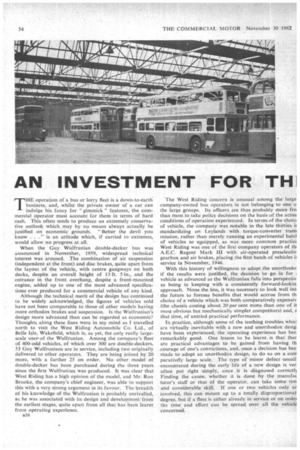AN INVESTMENT FOR TH
Page 56

If you've noticed an error in this article please click here to report it so we can fix it.
THE operation of a bus or lorry fleet is a down-to-earth business, and, whilst the private owner of a car can indulge his fancy for " gimmick " features, the commercial operator must account for them in terms of hard cash. This often tends to produce an extremely conservative outlook which may by no means always actually be justified on economic grounds. "Better the devil you know . . . " is an attitude which, if carried to extremes,
would allow no progress at all.
When the Guy Wulfrunian double-decker bus was announced in November, 1959, widespread technical interest was aroused. The combination of air suspension (independent at the front) and disc brakes, quite apart from the layout of the vehicle, with centre gangways on both decks, despite an overall height of 13 ft. 5 in., and the entrance in the front overhang, despite a front-mounted engine, added up to one of the most advanced specifications ever produced for a commercial vehicle of any kind.
Although the technical merit of the design has continued to be widely acknowledged, the figures of vehicles sold have not been comparable to those of other models having more orthodox brakes and suspension. Is the Wulfrunian's design more advanced than can be regarded as economic'? Thoughts along these lines were in my mind as I travelled north to visit the West Riding Automobile Co. Ltd., of Belle Isle, Wakefield, which is, as yet, the only really largescale user-of the Wulfrunian. Among the company's fleet of 400-odd vehicles, of which over 300 are double-deckers, 53 Guy Wulfrunians are in service, including two originally delivered to other operators. They are being joined by 20 more, with a further 25 on order. No other model of double-decker has been purchased during the three years since the first Wulfrunian was produced. It was clear that West Riding has a high opinion of the model, and Mr. Ron Brooke, the company's chief engineer, was able to support this with a very strong argument in its favour. The breadth of his knowledge of the Wulfrunian is probably unrivalled, as he was associated with its design and development from the earliest stages, quite apart from all that has been learnt from operating experience, B38
The West Riding concern is unusual among the large company-owned bus operators in not belonging to one o the large groups. Its officers are thus probably more fre than most to take policy decisions on the basis of the actua conditions of operation experienced. In terms of the choio of vehicle, the company was notable in the late thirties ii standardizing on Leylands with torque-converter trans mission, rather than merely running an experimental batcl of vehicles so equipped, as was more common practice West Riding was one of the first company operators of th, A.E.C. Regent Mark III with air-operated preselectiv gearbox and air brakes, placing the first batch of vehicles i; service in November, 1946.
With this history of willingness to adopt the unorthodo: if the results were justified, the decision to go in for vehicle as advanced as the Wulfrunian falls into perspectiv as being in keeping with a consistently forward-lookin approach. None the less, it was necessary to look well int, the future to foresee benefits that would accrue from th choice of a vehicle which was both comparatively expensiv (the chassis costing about 20 per cent more than one of it most obvious but mechanically simpler competitors) and, that time, of untried practical performance.
In.practice, although some of the teething troubles whicl are virtually inevitable with a new and unorthodox desig: have been experienced, the -operating experience has bee remarkably good. One lesson to be learnt is that ther are practical advantages to be gained from having th ,courage of one's convictions, and, once a decision has bee made to adopt an unorthodox design, to do so on a corn paratively large scale. The type of minor defect usual' encountered during the early life of a new design is ver often put right simply, once it is diagnosed correct!) Finding the cause, whether it is done by the ,manufa< turer's staff or that of the operator, can take some tim and considerable skill. If one or two vehicles only ar involved, this canmount up to a totally disproportionat degree, but if a fleet is either already in service or on orde; the time and effort can be spread over all the vehicle concerned.




































































































